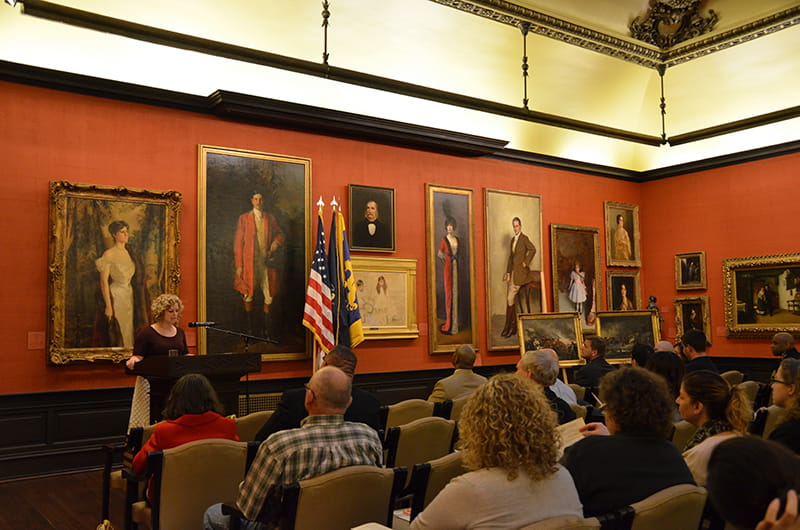Employee Spotlight: Lynn Clouser, Director of The Drexel Collection and Advocate for the University's Art Collection
 By Jared Brey
By Jared Brey

Of the more than 6,000 artifacts in The Drexel Collection — from the fine, handcrafted home goods of 19th-century Europe to photographer Larry Clark’s gritty, degenerate “Tulsa” series — at any one time about a quarter are on display. It’s Lynn Clouser’s job to decide which ones to show and how to show them.
“The first round of exhibitions that I was responsible for was all internal,” said Clouser, who started at Drexel in 2012 and became director of The Drexel Collection last year. “It was stuff out of our collection. We looked at what we had and said, ‘OK, we have coins. Let's do a coin show.’”
Over time, the displays have become more sophisticated as Clouser has worked with students to remix the collection and exhibit its pieces in various thematic ways. Take, for example, Holding Your Drink: 3,000 Years of Drinking Vessels from the Drexel and Salzberg Collections, which was on display in the Rincliffe Gallery on the third floor of Main Building this winter. Clouser said her inspiration for the show was sparked by a single artifact: A silver monteith, or wine glass cooler, that came from the collection of Philip Syng Physick Fell, a great-grandson of University founder Anthony J. Drexel. Working with Distinguished Teaching Professor Derek Gillman and students in the Westphal College of Media Arts & Design’s museum leadership graduate program and entertainment and arts management program, Clouser helped guide the students to develop the idea into an exploration of the significance of drinking.
“The overall theme of the show was drinking vessels, but the difficulty is in categorizing them,” said Clouser. “Students came up with these themes. There's the social aspect of drinking. There's the function of the objects: this one stores the drink, this one you drink from, this one pours the drink. Then there are the ingredients that go into alcohol. We brainstormed all the big ideas that a drinking vessel could speak to and then the students picked which ones they wanted to focus on.”
Her own focus as a student was less clear, however. When she was in college at the University of Delaware — she’s a native of the state and still lives there — Clouser said she felt pulled in two directions.
“I knew that I liked art, and I was an artist,” said Clouser. “But I didn't want to walk away from science. I loved chemistry classes and biology classes, so I was trying to create a major that combined art and science.”
She found the right balance in art conservation as an undergraduate and discovered the museum field. She continued her education with a master's degree in art and museum studies from Georgetown University and Sotheby’s Institute of Art, London with a focus on preventive conservation and European design and decorative arts. While in graduate school, Clouser worked at internships at the Barnes Foundation in Merion — before it was moved to Philadelphia — and at the National Portrait Gallery in Washington, D.C., later joining the Winterthur Museum, Garden and Library in Wilmington as a cataloger. Since joining The Drexel Collection in 2012, first as assistant curator and then as assistant director, Clouser has worked on around two dozen exhibitions at the University.
One of the trickiest and most rewarding shows was Awareness: Larry Clark’s Tulsa Series. The series of photographs, first published in 1971 by the filmmaker who later directed the controversial 1995 film “Kids,” included sometimes jarring depictions of young people using drugs, having sex and brandishing weapons. Clouser said that she had to figure out how to display the images in the very public Rincliffe Gallery without offending people who were just walking by on their way to class. The solution was blacking out the front-facing portion of the glass display cases, so passersby had to step into the display area to view the art.
“What I thought was most surprising was how many of the students knew who he was, and that they really connected with his art,” said Clouser. “You get the occasional photography student walking by and they go, ‘Wait, what? You have original Larry Clark photos?’ … It was so exciting just to see the response from the community.”
Clouser’s role has become increasingly educational and focused on getting the Drexel and local communities involved. She now regularly collaborates with students on exhibitions — like the current exhibit, Stories in Self-Portrait, which was curated by Tim Gorichanaz, a PhD candidate in the College of Computing and Informatics and featured work from local Philadelphia artists. The majority of her teaching, however, is done one-on-one with students doing hands-on practical work with the Collection for co-ops and other internship and professional opportunities. She also frequently assists with courses in the Westphal College of Media Art and Design’s art history and museum leadership programs.
That’s not to say that she doesn’t work with students outside of museum or art majors. Indeed, classes from any discipline in the University are welcome to use The Drexel Collection’s objects as teaching tools — as an English professor did a few years ago (as covered by DrexelNow) to give students a visual aid of the type of Dresden porcelain that features in Kurt Vonnegut’s “Slaughterhouse-Five” novel.
While all of that teaching and support and mentoring isn’t usually required of museum curators, it makes sense for Clouser — and for the University — to incorporate that into her essential job responsibilities. After all, The Drexel Collection was founded in 1891 (as “the Drexel Museum”) with the start of the Drexel Institute of Art, Science and Industry as an instructional tool “to teach good design,” according to Clouser. Even back then, students and faculty used The Drexel Collection to support courses, especially when Drexel had an art department. Now, Clouser is working to expand The Drexel Collection’s role by creating more partnerships with more Drexel colleges and schools and including more of the University community in the activities of The Drexel Collection.
“Education was the original museum’s mission and it is what I find I am more actively involved in now with The Drexel Collection,” said Clouser. “It's really rewarding and a fun part of my job.”
This story was published in the spring 2018 issue of Drexel Quarterly.In This Article
Drexel News is produced by
University Marketing and Communications.
